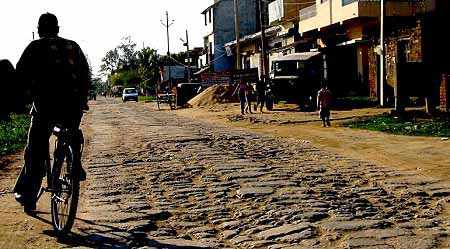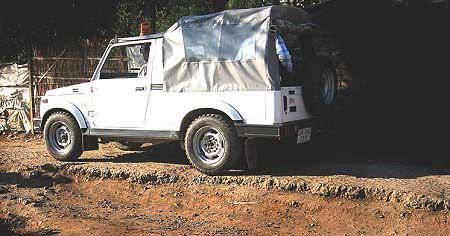|
Travelling
about 50 km via NH2 from Aurangabad to Dobhi was no less than a joy ride.
It always feels great when we experience something convenient for the
people like the Golden Quadrangle. However, once I entered the Gaya city,
I woke up from the dreamy El Dorado that my country would become one day.
Now I was, it seemed, on a real plane with uneven and rickety roads with
deep ditches and broad pits having covered with filthy mud waters at places.
The man pulling the rickshaw had a better idea how, when and why to take
turns, speed up or take brakes, and I believe any new customer on the
pedal would surely find it difficult to crawl on a snail pace, as road
was hardly visible due to muddy water overflowing over it.

Pix:
Manish Sinha
Riding on rickshaws
is highly risky in cities of Bihar, especially in the night when there
is a blackout or dimly-lit way ahead. The most difficult question for
pedestrians is how to walk properly on slippery roads and encroached pavements
where any wrong step could lead you in a shallow shit, if not deep. The
glaring truth about road infrastructure is mingboggling, as most of the
roads that I found to be in utter dilapidated conditions asking for immediate
repairs, and those near the market places are covered with piles of rotten
spinaches and peels of various fruits and vegetables.
This is not the case
of one city only: equally dilapidated conditions of roads (MDR) are to
be found in Nawadah, Jehanabad, Bhagalpur, Sitamarhi and Biharsharif cities
where people seem to be contented with bad roads and unhygienic environment
or think it to be their fate. They wait for the government to do something,
while the government does on its own pace or rather no pace. We, the citizens
too, are equally to blame for the bad conditions of roads. At least, we
can go for complaints and frequent asks so that inert officials and insensitive
leaders could do a bit, if not much.
Sometimes back when
India was reeling under the malarial and dengue fever onslaught I wrote
a mail to the district magistrate, Gaya to have stroll round the city,
it is another matter he did not even bother to make a reply, leave alone
the remedial efforts. The drains are still full of filth, not cleared
for months and breeding grounds of mosquitoes. So, another endemic breakout
would not be a surprise.
Years of misrule has
mad a mess of roads in Bihar, both rural and urban roads on which the
number of vehicles continues to rise every year, in addition to population.
At peak hours, one can witness the absolute bedlam at every important
crossings and junctions in cities. Crowds of vehicles are found to be
beeping and honking for ways, which are not there because of the squeezing
spaces filled with hurrying commuters and cycle riders aided and abetted
with open drainage. Shouts, shoves and skirmishes are normal; even traffic
policemen are found to be either missing or become the mute spectators.

Pix:
Manish Sinha
And what about the
village roads? The less said the better. I wondered how a jam-packed bus
with a big crowd on the roof was speeding towards Narhat on uneven gravel
way called road! And I wondered how people venture to travel in such risky
conditions. One road, for example, from Harihargunj to Aurangabad - a
distance of 30 km - that I travelled are highly dangerous by any standards.
On hired Maruti, journey was headachsome, while via bus it was painful,
because I could see the unlimited crowd left no space for breathing. And
after such an exhausting travel, you are completely bankrupt - physically
and mentally. I pity the daily goers, for whom it is no less than a sheer
bravery, but an act borne out of helplessness.
Significance of Infrastructure
Infrastructure plays an important part in economic development of a state.
Road is the chief means of communication for short distance travels. Bihar
has 2318 km of National Highways, 4192 km of State highways, 12,579 km
of district roads and over 69000 km of other roads. South Bihar has extensive
network of roads linking major industrial locations in the state. The
state would also encourage private sector involvement in maintenance of
roads and bridges.
Table-1
Road Lengths in Bihar
|
Category
|
Pucca
|
Kutcha
|
Total
|
|
NH
|
3,629.00
|
0.00
|
3,629.00
|
|
SH
|
2,382.47
|
0.00
|
2,382.47
|
|
MDR
|
8,457.00
|
0.00
|
8,457.00
|
|
ODR
|
2,935.00
|
990.00
|
3,925.00
|
|
Village
|
27,400.00
|
35,861.60
|
63,261.63
|
|
Total
|
44,803.47
|
36,851.60
|
81,655.10
|
Source:
Government of Bihar
Though Table-1 shows
that there is no kutcha road in cities (MDR), they are no better than
even kutcha roads either, if they happen to be smooth. The glimpse of
road construction work was visible in parts of rural area about 40 km
from Daltangunj. Oh, but that is Jharkhand now! I realised later.
Bihar can boast of
4/6-Lane Super Highway under the Golden Quadrilateral Project, which covers
Mohania, Sasaram, Aurangabad, Sherghati and Bhaluachatti, while the East-West
Corridor passes through northern districts such as Gopalganj, Muzaffarpur,
Darbhanga, Phulparas, Forbesganj, Araria, Purnea and Kishanganj. The state
has quadrilateral entry for the movement of goods and passenger traffic.
While we can boast that the Indian road network is the second largest
in the world, and the total length of roads, which was 4 lakh km in 1950-51,
increased to 33 lakh km in 2006-07, repair works have found least attention.
Better roads hold
greater significance for the rural areas of Bihar. According to a World
Bank Report of 1997, it is estimated that 15 percent of crop produce is
lost between the farm gate and the consumer because of poor roads and
inappropriate storage facilities alone, adversely influencing the income
of farmers. A study of infrastructure development says that development
of transport and communication infrastructure enhances the mobility of
people and information through reduction in cost and time. The resulting
increase in interaction contributes to changes in attitudes and human
capital development. In addition to facilitating agricultural commercialisation
and diversification, rural infrastructure, particularly roads, consolidates
the links between agricultural and non-agricultural activities within
rural areas and between rural and urban areas.
A USAID report says
that the ex-poste study of the effects of rural roads improvement in the
Philippines revealed improved economic social and human services indicators,
as a result of improvement in rural roads. The gross household income
increased by 28 percent primarily due to cheaper and more reliable transport,
cheaper farm inputs, higher farm gate prices and large share of major
crops sold directly in markets. There was increased non-farm employment,
better access to education, health and farm management services, improved
recreation facilities and information flows.
In a new dawn of good
governance that the people of Bihar have started smelling with the arrival
of the new government, the expectations are high. What is needed is the
focused approach towards infrastructure development, especially betterment
of means of communication, among others, which would ultimately fetch
investment to the state. And this is one area in which people have least
intervention; it is the government that would help build roads. There
is but truth why all roads lead to Rome. Let us pause for a while.
Comment
|
|
India
Business Directory
|
|
|
|
|
|
|
|
|
|
|
|
|
|
|
|
|
 |
|